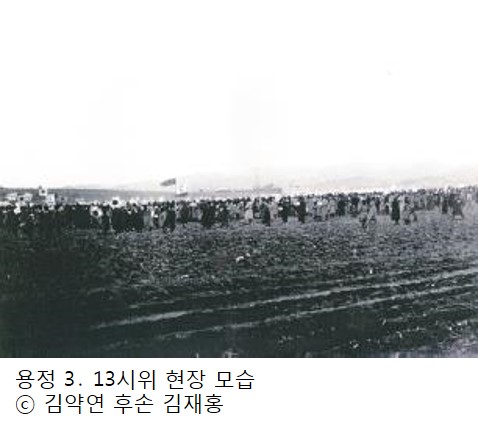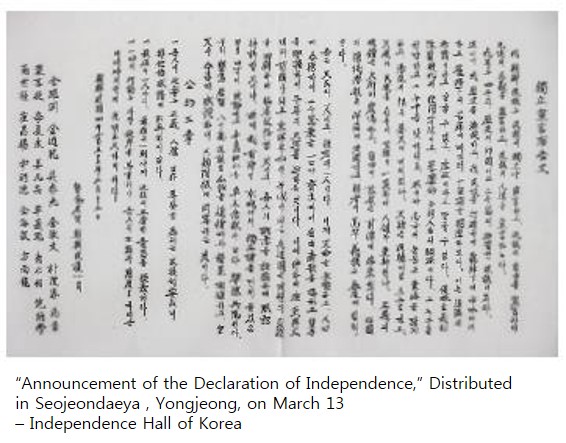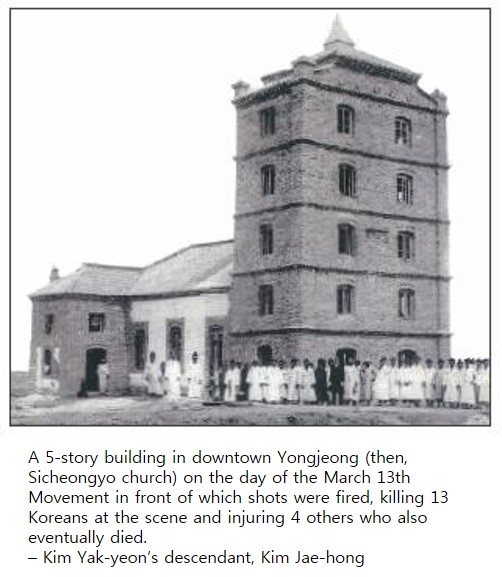동북아역사재단 2019년 03월호 뉴스레터
- Chang, Se-yun(Director of Operation and Planning at the Northeast Asian History Foundation)
From March 1, 1919 onward, the "Mansei" movement that cried out for independence spread like wildfire in Korea. This movement involved individuals from all social strata, transcending age, status, and gender, and eventually grew out of Korea and overseas. This year's new column series, "Looking Back on the March 1st Movement," discusses lesser-known or new stories about the March 1st Movement that shook the country 100 years ago.
March 1st Movement Resonates in Overseas Korean Communities
 Recently,
it was the 100th anniversary of the March 1st Movement. We are all well-aware
of the exceptional significance of this day, the centennial of both the March
1st Movement and the Provisional Government of the Republic of Korea. The March
1st Movement not only spread all throughout Korea, but it also became a
sensation in Manchuria (northeastern China) where a significant number of
ethnic Koreans reside. Notably, up to 30,000 ethnic Koreans participated in the
"Manse" movement that took place on March 13, 1919 (Thursday,
Feburary 12 on the lunar calendar) in Yongjeong, North Gando (now, China's
Yanbian), crying out for national independence and liberation. Today, academia
in Yanbian calls this movement the "March 13th Anti-Japan Protest
Movement," or the "March 13th Mass Anti-Japan Movement."
Recently,
it was the 100th anniversary of the March 1st Movement. We are all well-aware
of the exceptional significance of this day, the centennial of both the March
1st Movement and the Provisional Government of the Republic of Korea. The March
1st Movement not only spread all throughout Korea, but it also became a
sensation in Manchuria (northeastern China) where a significant number of
ethnic Koreans reside. Notably, up to 30,000 ethnic Koreans participated in the
"Manse" movement that took place on March 13, 1919 (Thursday,
Feburary 12 on the lunar calendar) in Yongjeong, North Gando (now, China's
Yanbian), crying out for national independence and liberation. Today, academia
in Yanbian calls this movement the "March 13th Anti-Japan Protest
Movement," or the "March 13th Mass Anti-Japan Movement."
The Japanese consulate underreported the number of participants, claiming that only 6,000 individuals participated in the movement. However, Chinese authorities confirmed that there were over 20,000 Korean participants, while Gye Bong-woo alleges that the number of participants exceeded 30,000.
 The
"Announcement of the Declaration of Independence" was released during
the March 13th Movement in Yanbian. The Declaration was written under the name
of, "All Koreans of Gando." At the time, the "Announcement of
Joseon's Declaration of Independence" was released under the name of 17
"national representatives from the North and South Gando," including
Kim Yak-yeon. Kim Yak-yeon was a highly prestigious governor from the Yanbian
area, prominent enough to later be called "President of Gando." He
and other community leaders recognized the new momentum that arose at the end
of World War I with the reorganization of international order involving
Russia's Maritime Province, China's Shanghai, and Japan's Tokyo. This
recognition was expressed in the form of the March 13th Protest Movement.
Surprisingly, after the "March 13th Independence Celebration: Yongjeong
March 13th Movement," they organized two strategies: sending delegates to
the Paris Peace Conference to receive support from the World Powers, and
demanding independence after organizing a do-or-die squad and entering Korea.
After independence was declared during the March 13th Movement and the
"Independence Celebration" was held, the leaders believed that it was
the time to establish an independent government that was neither a despotic
monarchy nor a constitutional monarchy, but rather a government that took the
form of a republican government. Particularly, the logic and assertions for the
need for a republican government, such as the Provisional Government, spread
widely.
The
"Announcement of the Declaration of Independence" was released during
the March 13th Movement in Yanbian. The Declaration was written under the name
of, "All Koreans of Gando." At the time, the "Announcement of
Joseon's Declaration of Independence" was released under the name of 17
"national representatives from the North and South Gando," including
Kim Yak-yeon. Kim Yak-yeon was a highly prestigious governor from the Yanbian
area, prominent enough to later be called "President of Gando." He
and other community leaders recognized the new momentum that arose at the end
of World War I with the reorganization of international order involving
Russia's Maritime Province, China's Shanghai, and Japan's Tokyo. This
recognition was expressed in the form of the March 13th Protest Movement.
Surprisingly, after the "March 13th Independence Celebration: Yongjeong
March 13th Movement," they organized two strategies: sending delegates to
the Paris Peace Conference to receive support from the World Powers, and
demanding independence after organizing a do-or-die squad and entering Korea.
After independence was declared during the March 13th Movement and the
"Independence Celebration" was held, the leaders believed that it was
the time to establish an independent government that was neither a despotic
monarchy nor a constitutional monarchy, but rather a government that took the
form of a republican government. Particularly, the logic and assertions for the
need for a republican government, such as the Provisional Government, spread
widely.
This matter can be verified through reports made by Chinese authorities who suppressed students and crowds who tried to participate in the March 13th Anti-Japan Protest Movement in Yongjeong. The Chinese authorities reported the enthusiasm of Koreans, stating, "On March 13, after breaking up 20,000 protestors at a six-way intersection in Yukdogu, instructions calling for emergency supervision and prohibition of such gatherings were delivered to each district and wharf. However, the fervor was like a tide, creating an unstoppable situation." At noon on March 13, as the purpose of the independence celebration was explained following the reading of the Declaration of Independence, cheers that shook heaven and earth rang out in celebration of Joseon's independence while crowds jumped for joy, wept in joy, and waved the Taegeukki (Korean flag). One cannot help but admire the great devotion and sincerity of the Koreans, and it cannot be assumed that even after independence they wanted a form of government ruled by the emperor of the ruined homeland. The evidence can be found in the "Announcement of the Declaration of Independence," which was distributed at the March 13th Anti-Japan Protest Movement.
17 Dead and Over 30 Injured During Demonstrations; Forgotten Patriots Must be Remembered and Commemorated
 Unfortunately,
under the pressure of Japanese imperialism, Chinese authorities opened fire
during the March 13th Movement, resulting in 17 deaths and 30 injuries. 13
people including Gong Deok-heub, the vanguard of the protest movement, and
Hyeon Bong-ryul died on the scene. Four others, including Kim Jong-muk, died
after being hospitalized at Jechang Hospital. The 17 patriots who devastatingly
died were buried in the hills of Heocheong-ri (now, Habseong-ri) in southern
Yongjeong, while being mourned by 5,000 Koreans. Today, this area is called the
"The Graveyard of March 13th Anti-Japan Patriots."
Unfortunately,
under the pressure of Japanese imperialism, Chinese authorities opened fire
during the March 13th Movement, resulting in 17 deaths and 30 injuries. 13
people including Gong Deok-heub, the vanguard of the protest movement, and
Hyeon Bong-ryul died on the scene. Four others, including Kim Jong-muk, died
after being hospitalized at Jechang Hospital. The 17 patriots who devastatingly
died were buried in the hills of Heocheong-ri (now, Habseong-ri) in southern
Yongjeong, while being mourned by 5,000 Koreans. Today, this area is called the
"The Graveyard of March 13th Anti-Japan Patriots."
After learning the news about the March 13th Movement late, Confucian scholar and historian Kim Jeong-gyu vividly recorded the unfortunate circumstances under which Kim Jin-se (real name Kim Mun-heon), a relative, got injured in his diary:
“It is the righteous passion of a man of fidelity who selflessly throws himself into a difficult situation, and rescuing relatives in need of money is what relatives must to first. During the independence movement of last spring in Gando, it was those who did not think of dying who met the angels. No other person would have risked his life to take the lead while waving the flag and shouting in protest. How heroic is that? Alas, many words are not necessary, as they will not revive the deceased. Kim Jin-se was born to a poor family and lived a meager life. He had elderly parents and many younger siblings. The family's livelihood rested upon him, his body, which was entirely dependent on his legs. He lost one leg. What would become of his family members!"
It is quite a sad and terrible story.
We must remember and pay homage to the righteous individuals who braved hardships and sacrificed themselves in this difficult time. We must strive for a desirable future that realizes justice, humanitarianism, and conscience, while engraving in our minds the meanings and lessons of today.


